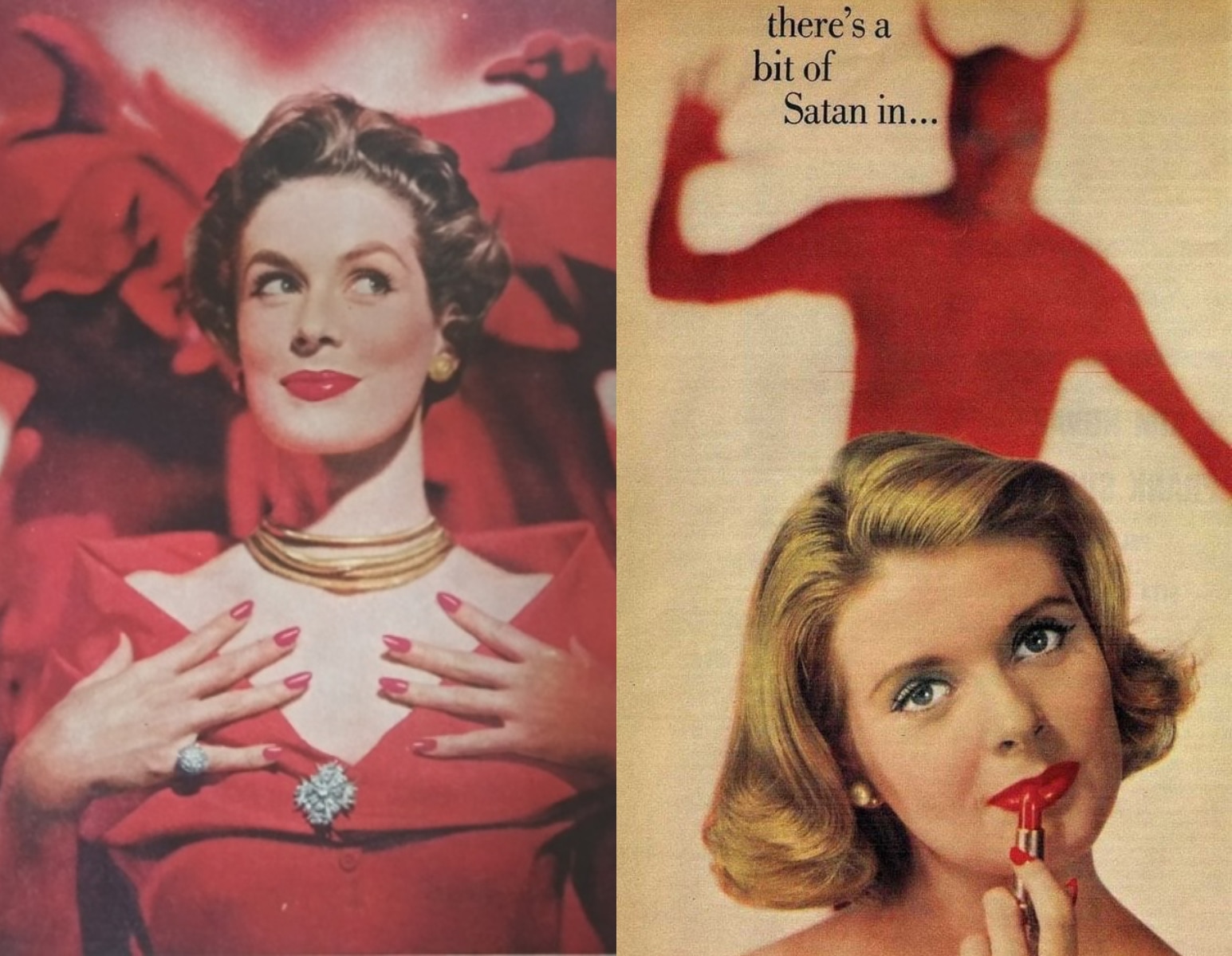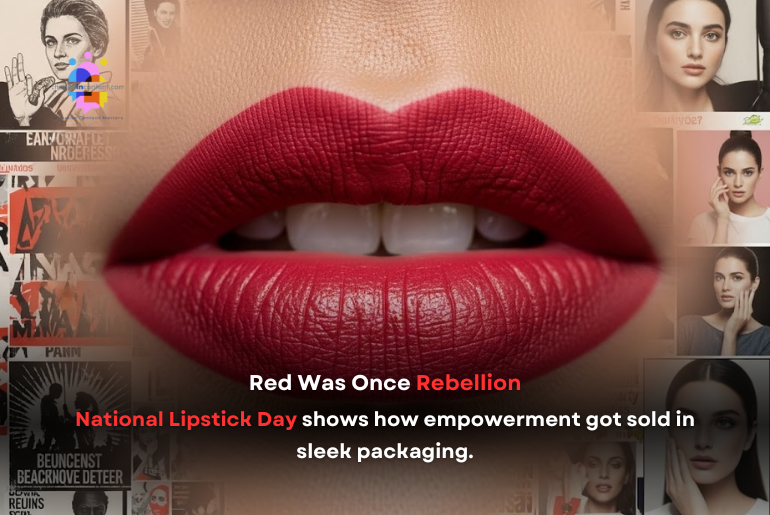July 29th is National Lipstick Day. In 2016, Huda Kattan, founder of Huda Beauty, an entrepreneur and a beauty blogger, was declared to be the modern-day creator of National Lipstick Day by a Proclamation from the National Day Calendar’s Registrar. However, lipstick had already been honoured in small, informal ways before 2016, even as it carried a controversial legacy.
Lipstick in History: Witchcraft, War, and Defiance
Lipstick has not always been celebrated. In fact, it has been condemned, feared, and even banned. In 1770, the British Parliament claimed that women who wore lipstick used it as a trick to seduce men into marriage. The parliament decided to declare it as witchcraft. At different points, religious groups associated lipstick with witchcraft, treating it as a dangerous or immoral practice.

In ancient Greece, women of ill repute or “fallen women” had to wear lipstick to distinguish themselves from respectable women. Women from respected families did not wear lipstick. Red lipstick, instead, was linked to women who were considered “immoral.” They were even pushed to wear it so men could easily recognise them in public. Even Queen Victoria expressed disdain, calling makeup improper and dishonourable for respectable women.
Red Lipstick in World War II
Red lipstick has carried more history than most realise. In World War II, it became a weapon of morale as much as a shade of glamour. Ironically, Adolf Hitler made it famous by hating it. He tried to ban cosmetics, especially red lipstick, because he saw painted lips as rebellious. The Allies quickly turned that into an opportunity. Governments encouraged women to wear red lipstick as a sign of defiance. In Britain, Winston Churchill promoted it as part of the war spirit. In the United States, manufacturers began creating special lipstick, blush, and nail varnish for women in uniform.
Cosmetic brands joined the war propaganda, naming lipsticks with military flair such as “Victory Red,” “Combat,” “Regimental” to send the message that swiping on a red shade made every woman a soldier in spirit.

For generations, wearing lipstick meant defiance. A red lip was a rebellion against authority, a statement against the rules that tried to dictate how women should live. Today, however, lipstick has taken on a new life. The beauty industry often sells it as a tool of empowerment. Campaigns celebrate it as a symbol of confidence and self-expression.
But is lipstick in the 21st century truly a sign of empowerment, or is it just another marketing trick?
Is Lipstick really empowerment?
Once, wearing a bold lipstick was an act of rebellion. Today, brands often repackage it as a tool of empowerment, using it as clever marketing when real issues of women’s empowerment remain ignored.
Take Hilary Rhoda’s Lipstick Day 2025 campaign. It does well to highlight the old taboos and generational conditioning tied to lipstick. In the ad film, a teenage girl wears red lipstick, only to be stopped by her distressed mother. The girl responds with a “Kyun Nahi?” (Why not?). Through this, the campaign questions why a girl’s choice to wear lipstick or any makeup at all links with “log kya kahenge” (what will people say) or “abhi chhoti ho” (you’re too young).
Of course, the campaign managed to bring attention to the history of moral policing and cultural shame passed down as rules. But can we claim lipstick in this era is a symbol of empowerment for women? We would argue it is not.
The illusion of empowerment in beauty marketing
See, the beauty industry is built on women’s insecurities. If you have dark circles, there’s a concealer. If your skin has visible pores, which is entirely normal, there’s a primer or a pore-vanishing foundation. Lipstick is no different, especially for women in South Asia or women of colour. Brands market shades that “fix” two-toned lips, promising to hide what is natural. They sell “brightening” lipsticks that claim to make lips baby pink or baby soft. None of this is empowering.
Campaigns often use catchy slogans like “Because you’re worth it” or “Wake up flawless,” pretending to encourage confidence while subtly saying that women must correct themselves before being seen. The rise of influencer marketing has made this worse. Teenagers scroll through endless videos showing lip plumpers, glosses, or shade matches that promise a “perfect pout.” For them, these young girls, makeup becomes less about choice and more about pressure.
The hidden side
Then there is the hidden side that glossy ads never show. While one woman may use lipstick as a symbol of empowerment, another may be trapped in the very system that produces it. Unethical sourcing practices, hidden child labour, and modern-day slavery still exist in the supply chains of beauty brands. Unlike industries such as food or textiles, beauty operates with weaker regulation. This lack of accountability makes it easier for companies to overlook, or even ignore, exploitation tied to the products they market as tools of “freedom.”
Earlier, wearing lipstick was a rebellion, a refusal to play by society’s rules. Today, not wearing it would feel more radical. In a world that demands women stay polished and pageant-ready at all times, a bare face becomes a statement in itself. Refusing the script of “fix this, brighten that” challenges the very system that profits from women’s self-doubt.
National Lipstick Day: Identity or illusion?
Hilary Rhoda’s campaign attempted to present lipstick as an extension of identity, a way for women to claim their space. In some ways, this is true. Makeup can be artistic, personal, and expressive. For many, it’s a canvas for creativity. However, when empowerment is wrapped up and sold in sleek packaging, is it empowerment?
The truth is, beauty marketing rarely celebrates women who already feel enough. Instead, it whispers that something is always lacking. A lipstick to look bolder, a foundation to look flawless, a cream to “fix” what was never broken in the first place.
Women’s empowerment, it seems, has become another product on the shelf.
Conclusion: Real empowerment beyond National Lipstick Day
Lipstick carries a long history. From being banned to being branded as witchcraft, from being revolutionary to being marketed as empowerment today, it has worn many meanings. What was once rebellion against societal norms is now a billion-dollar industry’s marketing strategy.
The question then is not whether lipstick should be celebrated or rejected. The question is whether we allow an industry to define what empowerment looks like. If a woman chooses to wear lipstick because she enjoys it, it remains her choice. However, if she feels forced to wear it to be considered “presentable,” then empowerment slips out of the picture.
National Lipstick Day can bring creative and engaging campaigns, but it also reveals how easily industries convert rebellion into branding. Real empowerment lies not in a shade of red, but in breaking free from the rules that still dictate how women should appear and behave. Lipstick may be a symbol of confidence, but it cannot replace the deeper changes society still needs.
Changeincontent perspective
At Changeincontent, we believe that we cannot reduce empowerment to a product. Lipstick can be art, identity, or joy, but brands should not sell it as the solution to systemic inequality. National Lipstick Day reminds us that rebellion often gets co-opted by industries that profit from women’s insecurities. True empowerment begins when women define themselves, beyond the shade of red on their lips.
Also Read: Makeup for kids: Is the beauty industry turning childhood into a market?
Disclaimer: The views expressed in this article are based on the writer’s insights, supported by data and resources available both online and offline, as applicable. Changeincontent.com is committed to promoting inclusivity across all forms of content. We broadly define inclusivity as media, policies, law, and history. It encompasses all elements that influence the lives of women and marginalised individuals. Our goal is to promote understanding and advocate for comprehensive inclusivity.


